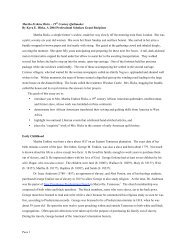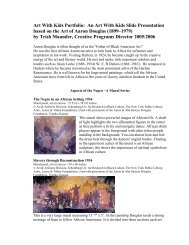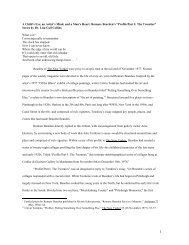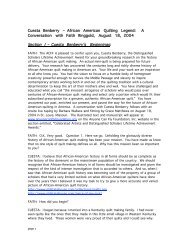Antonio Pollaiuolo’s Battle of the NakedMen (c.1465) in <strong>The</strong> Metropolitan Museum ofArt collection must have caught Barthé’s eye onhis many visits to that museum. <strong>The</strong> etching,picturing what appears to be man’s battle withhis many identities, contains identical models ina variety of poses. <strong>The</strong> scene is static, eventhough a fierce battle is underway, andintensified by how difficult it is to distinguishenemies from comrades among them.Unprotected bodies stretch out and open like<strong>Feral</strong> <strong>Benga</strong> exposed to the sharp metal ofsweeping weapons. Although standing alone, a similar tension is sensed in <strong>Feral</strong> <strong>Benga</strong> as onemoves around to set the figure in motion. <strong>The</strong> dancer appears vulnerable and unstable from theside, powerful and unpredictable from the front, and decidedly erotic from behind. Whenwielding a heavy blade such as that hanging above <strong>Feral</strong> <strong>Benga</strong>’s head, one miscalculated movewould surely result in injury.<strong>The</strong> art historical models for Barthé's sculpture areoften recognizable, but early critics overlooked Europeaninfluences when writing about African-American art becausesuch borrowing was believed to undermine the ‘originality’ ofblack expression. <strong>The</strong>refore, comparing <strong>Feral</strong> <strong>Benga</strong> to afifteenth-century Italian print was never considered.However, Barthé and Pollaiuolo have more thancompositional affinities. <strong>The</strong> public acceptance of both Battleof Naked Men and <strong>Feral</strong> <strong>Benga</strong> was due, in part, to theiridealized structures, which rendered nudity noble rather thansexual (at least on the surface). Mythological figures,theatrical performances, or images of far off continents likeAfrica and Asia offered a comfortable distance between artand audience for displaying the undressed body. However,black nudes based on classical models, a convention notwidely used in fine art, which did enjoy limited popularity as the ‘noble’ African savage in the18 th century, boldly resurfaced in the late 20 th century as Robert Mapplethorpe’s homoeroticphotographs proudly declare.Although <strong>Benga</strong> used his popularity as a native African to advantage in Paris and NewYork, he dreamed of forming an authentic West African dance troupe for European andAmerican audiences that did not compromise the fundamental passion of tribal movement. By1937, when he visited New York, Manhattan’s appetite for African dance was already whettedby Asadata Dafora and Randolph Sawyer who choreographed elaborate African-based dances forthe urban stage. 20 Even so, <strong>Benga</strong>’s beauty caused quite a stir in New York’s homosexualcircles. Prior to the advent of the gay liberation movement, homosexuals carefully guarded theiridentities in public. However, gay artists often deliberately employed high art portrayals of malenudity in covert celebration of a sexual orientation others deemed socially aberrant. <strong>Benga</strong>’sflawless, hairless, and often-exposed, brown skin inspired gay artists like Van Vechten and PavelTchelitchev. Both made portraits of the dancer during his New York visit. Van Vechten
photographed <strong>Benga</strong> holding white water lilies against his bare chest while staring into thecamera like an amphibian rising out of a pond. <strong>Benga</strong> also modeled for Tchelitchev’s paintingDeposition, a bizarrely oriented composition that leaves the viewer hovering over a naked man indespair being sucked into a void. <strong>Benga</strong>’s face and physique inspired others but Barthé's portraitstatuette had no equal.Alain Locke, one of several homosexual men of public stature from the HarlemRenaissance era, admired Barthé and collected his art. Locke was as careful as he was clever inmaintaining an uncompromisingly private advocacy of same sex relationships throughout hislife. He preferred the subtlety of Walt Whitman to the audacity of Oscar Wilde becauseWhitman was openly embraced as a man’s man without being marked as homosexual. 21 Locke,as expected, included <strong>Feral</strong> <strong>Benga</strong> along with a dozen other Barthé works in his 1940 pictorialsurvey <strong>The</strong> Negro in Art: A Pictorial Record of the Negro Artist and of the Negro <strong>The</strong>me in Artbecause Barthé's work elegantly merged Afrocentric themes with Eurocentric methods. Locke’scaption for <strong>Feral</strong> <strong>Benga</strong> read “<strong>Benga</strong>: Dance Figure” emphasizing the portrait and downplayingthe sensationalism inherent in the dancer’s stage persona as well as the figure’s nudity. 22<strong>Feral</strong> <strong>Benga</strong> was first exhibited in the celebrated 1937 Dance International exhibition atRockefeller Center, however, it was not pictured in the exhibition’s copiously illustrated catalog.<strong>The</strong> earliest of over a dozen published photographs of this popular sculpture was in Locke’s1940 survey. <strong>The</strong> sculpture’s photogenic quality made it the natural choice to illustrate laterexhibition catalogs and art historical texts. When reviewed together, these photographs areinstrumental for dating casts of known copies. New Jersey’s Newark Museum boasts the onlymuseum held cast of <strong>Feral</strong> <strong>Benga</strong> from the 1930s. Newark’s <strong>Feral</strong> <strong>Benga</strong> is one of only twoknown links to Barthé’s 1935 clay model. 23 Over fifty years later, subtle but significant changeswere made when Barthé, inspired by a revitalized interest in his early work, allowed the figure tobe cast in a new edition.At the height of his career, Barthé took great pains with the finish of his sculpture.Foundry work received vigilant scrutiny to ensure that the bronze was chased to a seamlessfinish and read true to its original clay model. <strong>The</strong> traces of pulled and smoothed clay createdwith fingers and tools animate figures like <strong>Feral</strong> <strong>Benga</strong> and act as a road map of Barthé'smeticulous rendering methods. This practice also reflected his admiration for the late 19 thcentury French master Auguste Rodin who left impressions on surfaces that are his signature.Barthé also chose his patinas with sensitivity. His belief in the visceral impact of colorcame from his formal training in oil painting. Newark’s <strong>Feral</strong> <strong>Benga</strong>, a deep blackened brown,perches on a round, thin disk pooled under the figure’s feet like a spotlight bathing over theperformer. Dominating the robust lower body, large bulging thighs are tensed by an elevatedpose struck on the balls of its feet. In contrast, the elastic midsection stretches up and fans outinto a ribcage that supports propelling arms forming parentheses along a vertical axis. <strong>The</strong>handle of the machete-arched overhead protrudes beyond the figure’s right palm, its sturdy bladeslightly widened before ending at a point that guides the eye down and around once more.Allusions to Sigmund Freud’s theories of phallic substitution and fear of castration aresimultaneously made as the only inorganic element, the machete, represents a literal andmetaphorical double-edged sword. <strong>Feral</strong> <strong>Benga</strong>’s portrait-quality face documents not only thelook of this engaging performer, but the psychic escape he found in dance.






